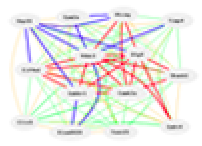

|

|

|
| | | | | | | | | | Welcome! Login |
Data Set Group2: UCLA BXD and BXH Cartilage
|
|
|
| Specifics of this Data Set: |
| None |
| Summary: |
| Summary of DatasetId 59, Name: UCLA BXD and BXH Cartilage J Bone Miner Res. 2011 Apr;26(4):747-60. doi: 10.1002/jbmr.271. Systems genetics analysis of mouse chondrocyte differentiation. Suwanwela J, Farber CR, Haung BL, Song B, Pan C, Lyons KM, Lusis AJ One of the goals of systems genetics is the reconstruction of gene networks that underlie key processes in development and disease. To identify cartilage gene networks that play an important role in bone development, we used a systems genetics approach that integrated microarray gene expression profiles from cartilage and bone phenotypic data from two sets of recombinant inbred strains. Microarray profiles generated from isolated chondrocytes were used to generate weighted gene coexpression networks. This analysis resulted in the identification of subnetworks (modules) of coexpressed genes that then were examined for relationships with bone geometry and density. One module exhibited significant correlation with femur length (r = 0.416), anteroposterior diameter (r = 0.418), mediolateral diameter (r = 0.576), and bone mineral density (r = 0.475). Highly connected genes (n = 28) from this and other modules were tested in vitro using prechondrocyte ATDC5 cells and RNA interference. Five of the 28 genes were found to play a role in chondrocyte differentiation. Two of these, Hspd1 and Cdkn1a, were known previously to function in chondrocyte development, whereas the other three, Bhlhb9, Cugbp1, and Spcs3, are novel genes. Our integrative analysis provided a systems-level view of cartilage development and identified genes that may be involved in bone development. PMID:20954177, PMCID:PMC3179327, DOI:10.1002/jbmr.271 |
| About the cases used to generate this set of data: |
| |
| About the tissue used to generate this set of data: |
| |
| About the array platform: |
| |
| About data values and data processing: |
| |
| Notes: |
| |
| Experiment Type: |
|
|
| Contributor: |
| |
| Citation: |
| |
| Data source acknowledgment: |
| |
| Study Id: |
| 59 |

|
Web services initiated January, 1994 as Portable Dictionary of the Mouse Genome; June 15, 2001 as WebQTL; and Jan 5, 2005 as GeneNetwork. This site is currently operated by Rob Williams, Pjotr Prins, Zachary Sloan, Arthur Centeno. Design and code by Pjotr Prins, Zach Sloan, Arthur Centeno, Danny Arends, Christian Fischer, Sam Ockman, Lei Yan, Xiaodong Zhou, Christian Fernandez, Ning Liu, Rudi Alberts, Elissa Chesler, Sujoy Roy, Evan G. Williams, Alexander G. Williams, Kenneth Manly, Jintao Wang, and Robert W. Williams, colleagues. |

|

|
GeneNetwork support from:
|
|||
| It took 0.080 second(s) for tux01.uthsc.edu to generate this page | |||
